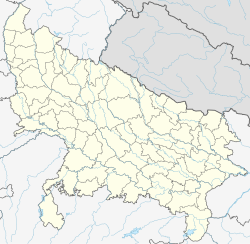Ahladpur
In this article, we will explore the topic of Ahladpur and its impact on contemporary society. From its emergence to its current evolution, Ahladpur has played a crucial role in various aspects of daily life. Throughout this analysis, we will examine the different aspects that make up Ahladpur, as well as its influence on culture, economy, and technology. Furthermore, we will also address the ethical and social implications associated with Ahladpur, as well as possible future perspectives. With a multidisciplinary approach, this article seeks to offer a comprehensive view on Ahladpur and its importance in the modern world.
Ahladpur | |
|---|---|
Village | |
| Coordinates: 26°58′14″N 78°55′09″E / 26.97068°N 78.91905°E | |
| Country | India |
| State | Uttar Pradesh |
| District | Mainpuri |
| Tehsil | Karhal |
| Area | |
• Total | 2.483 km2 (0.959 sq mi) |
| Population (2011)[1] | |
• Total | 3,186 |
| • Density | 1,300/km2 (3,300/sq mi) |
| Time zone | UTC+5:30 (IST) |
Ahladpur (Ahlādpur) is a village in Karhal block of Mainpuri district, Uttar Pradesh, India. As of 2011, it had a population of 3,186, in 516 households.
Demographics
As of 2011, Ahladpur had a population of 3,186, in 516 households.[1]: 149 This population was 54.2% male (1,725) and 45.8% female (1,461). The 0-6 age group numbered 387 (212 male and 175 female), or 12.1% of the total population. 86 residents were members of Scheduled Castes, or 2.7% of the total.[2]: 112–3
The 1981 census recorded Ahladpur as having a population of 2,143 people, in 172 households.[3]: 110–1
The 1961 census recorded Ahladpur as comprising 3 hamlets, with a total population of 1,699 people (898 male and 801 female), in 301 households and 215 physical houses. The area of the village was given as 614 acres.[4]: lvi
Infrastructure
As of 2011, Ahladpur had 1 primary school and 1 veterinary hospital. Drinking water was provided by well, hand pump, and tube well; there were no public toilets. The village had a post office and public library, as well as at least some access to electricity for all purposes. Streets were made of both kachcha and pakka materials.[1]: 142–7
References
- ^ a b c d "Census of India 2011: Uttar Pradesh District Census Handbook - Mainpuri, Part A (Village and Town Directory)" (PDF). Census of India. Retrieved 19 June 2023.
- ^ "Census of India 2011: Uttar Pradesh District Census Handbook - Mainpuri, Part B (Village and Town Wise Primary Census Abstract)" (PDF). Census of India. Retrieved 19 June 2023.
- ^ Census 1981 Uttar Pradesh: District Census Handbook Part XIII-A: Village & Town Directory, District Mainpuri (PDF). 1982. Retrieved 25 July 2023.
- ^ Census 1961: District Census Handbook, Uttar Pradesh (24 - Mainpuri District) (PDF). Lucknow. 1965. Retrieved 25 December 2021.
{{cite book}}: CS1 maint: location missing publisher (link)
